Stanley Submarine Ride
Although it is the antithesis of Extreme Shallow Snorkeling, this is without a doubt the single most amazing experience of my life. Our trip lasted about 4 1/2 hours and took us 2,000 feet below the ocean, deep into the Cayman Trench and to the depths below where light ever reaches.
Once we found out that Stanley Submarines were operating again after a hiatus to resolve administrative issues, we were eager to investigate. Steve at Coconut Tree Divers had been down and told us about the experience, sharing photos as well. Karl Stanley is the man behind Stanley Submarines, and the designer and builder of the Idabel, a three-man submersible designed for depths up to 3,000 feet. During our lunch break from diving, we headed to the Roatan Institute of Deep Sea Exploration, conveniently located on Half Moon Bay, where we were staying.
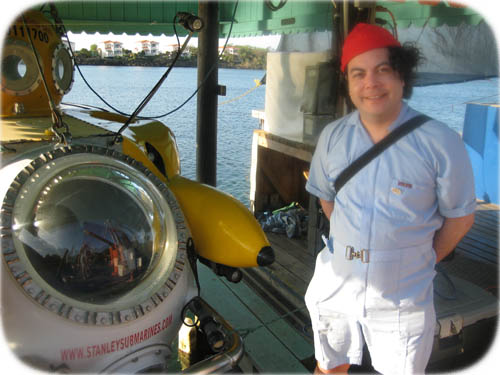
On the pier that serves as launching platform for the Idabel, we rang the scuba tank and Karl came out to greet us. We learned we could charter his vehicle, and he would serve as captain. Karl briefed us on the various options, from relatively short excursions to a specialized shark dive that would take up to seven hours. On dives focused on seeing Six-gill Sharks, Karl typically affixes a pig’s head to the submarine, then descends to 2,000 feet to wait in darkness until a Six-gill Shark larger than the sub finds and eats the head. Because we were interested in seeing a variety of life, Karl configured a custom itinerary for us that would take us to the deep sea reefs, the End of the Line, a boat Karl had sunk at 1,400 feet and other nearby areas.
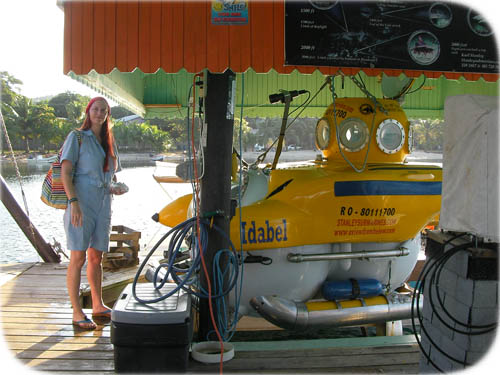
Safety was a concern. Madam J inquired if someone on shore would be apprised of our schedule and could send help if we did not return. Karl confirmed that there would be someone on shore who knew of our trip, but explained that help was not really an option in most cases, as there are no nearby submarines able to descend nearly as far. Currently, there are approximately 5 deep diving submarines that can go to 3,000 meters or more and no tourist submarines that can go as deep as the Idabel.
On the day of our charter, we met Karl at the dock in the morning. He had procured the innards of a pig, though the head had already been purchased by the time he reached the butcher shop. These innards were nailed into a wooden crate with some cinderblocks, and would serve as bait. We took a short trip to the buoy marking the End of the Line and Karl kicked the crate into the sea. We would see it about twelve hours later.
After a morning of diving and some lunch, we met Karl again at six pm at the submarine launch site. Our trip was scheduled for the evening because sharks and other deep sea creatures from well below 2,000 feet are more likely to come up at night. We were weighed to insure the proper amount of ballast was loaded onto the sub and various safety and operational checks were performed. We came dressed in long pants and other clothing not typically necessary in Roatan, because at depth, temperatures in the submarine drop significantly.
The Idabel is constructed from three steel spheres of different sizes – one of its kind – and is configured like a snowman sitting up at a right angle. It was assembled in Oklahoma. With the Idabel lowered from the roof of the pier by winch, we entered through a port on the top of the vertical section where Karl would later pilot the vehicle. Our cabin was the front bubble. We sat on a small bench in a space that was quite small, but comfortable enough for our trip. There is a large front window and a smaller window below in this section. The top of the submarine features a series of round windows giving Karl a 360 degree field of view.
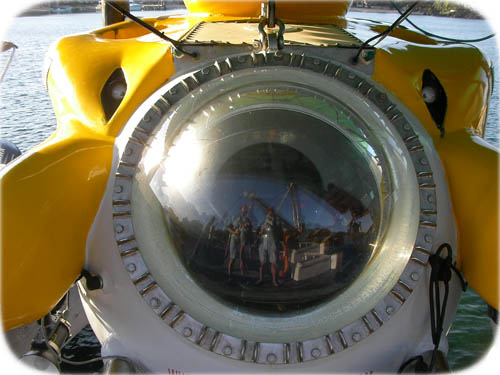
Once in, we traveled at the surface towards the buoy marking the End of the Line. Karl felt it would be best if we descended near that line as it was likely to feature more sea life. On the trip out Madam J felt a bit seasick, but was okay. As we first descended, the sub wobbled a bit, like a coin thrown into a fountain, but quickly settled. Our initial descent was fast, probably less than 1/2 hour to reach 1,400 feet. On our way down we saw a variety of small sea life, crustaceans and hypnotizing technicolor jellyfish mostly.
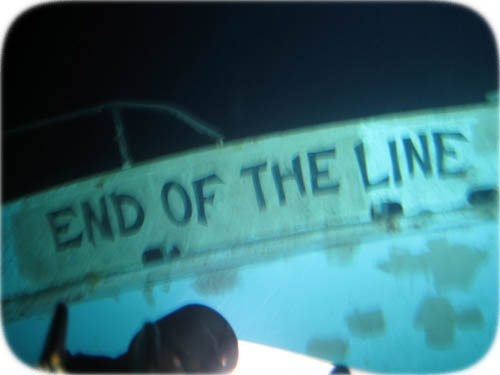
As we neared the End of the Line, Karl spotted a Six-gill Shark. Our footage of this prehistoric giant is very poor, but it was an exciting thing to see. These sharks are more closely related to sharks from the fossil record than most sharks alive today and typically are only found in deep sea waters. We think he may have smelled the bait box and came by to investigate. Unfortunately, we did not see him again on our expedition.
Our first stop was the End of the Line, where we found the bait box dropped that morning, almost exactly straight down from where Karl kicked it into the water. It was swarming with shrimp and lobster, as well as giant isopods, a prehistoric crustacean that is related to the pillbugs or roly-poly bugs in your garden, but about a foot long. One enterprising crustacean had pulled a string of small intestine far from the crate.
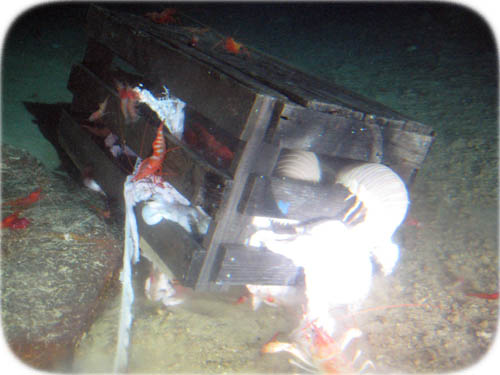
From there, we explored the nearby environs, spotting a Rattail fish, a large deep sea fish with a long tail. We also had a spectacular encounter with a Tinselfish, a very flat, round deep sea fish. The Tinselfish in particular seemed unperturbed by our presence, despite the bright lights shining upon it. We got many photos and videos of its surprised, confused expression.
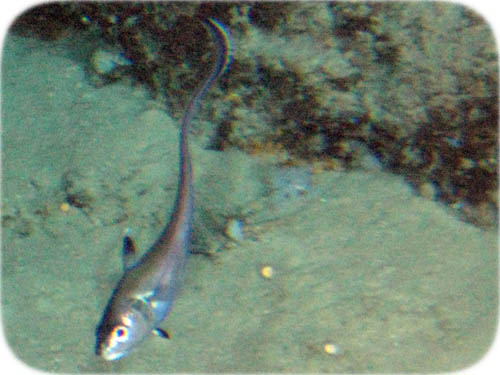
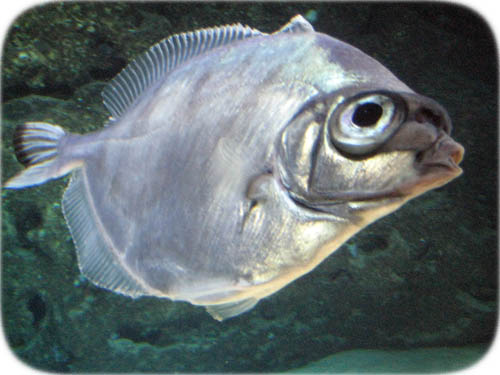
We then headed to deep sea reefs where corals at the edge of sunlight were covered with Brittle Stars and Squat Lobsters. These deep sea reefs were a strange reflection of their counterparts hundreds of feet above, They were vibrant with life in a dark, forbidding landscape, yet the creatures that crawled upon them were pale and ghostly. We visited several nearby corals and outcroppings.
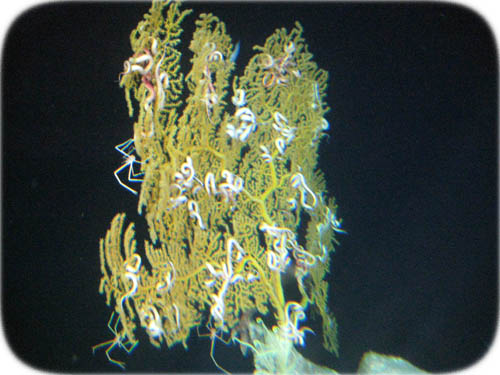
We headed back to the ship, and the bait box, seeing a giant isopod swimming over en route. The bait box was much as we left it, full of hungry creatures, but we did not find any more sharks or larger animals. At that point, we headed deeper, down to 2,000 feet below the surface. At 1,700 feet we had passed the far reaches of sunlight into an area of permanent darkness.
At 2,000 feet, we found a Tripod Fish, a peculiar fish that rests on a tripod of fins and has long whiskers coming from its head. We also saw delicate translucent sponges called Glass Sponges. Our most exciting encounter was with an unknown species of Catshark that had a mottled pinkish-reddish-tannish skin and large cat-like eyes. It stayed near the sub for some time, allowing us to capture some less than ideal photos and videos for later identification. It is possible that we are the only humans to ever see this species in its natural habitat.
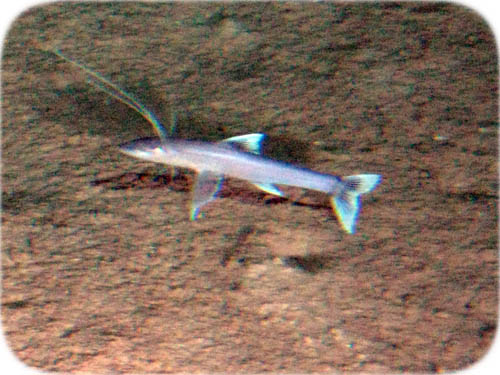
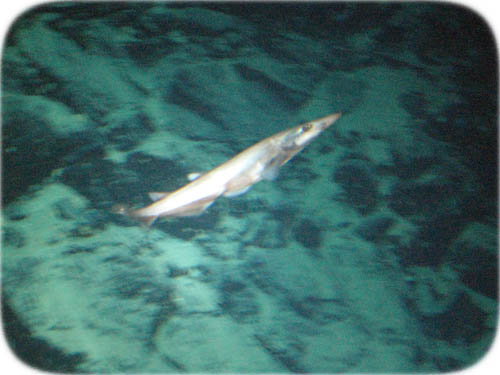
After this amazing encounter, we slowly made our way back to the surface. We stopped to check out an Orange Roughy and get a closer look at an Anglerfish patiently waiting on the sea floor. We traversed fields of ancient boulders and eventually, the wall leading up to the reef. We spotted deep sea nudibranch and urchins and deep sea coral formations perched on the undersea cliff.
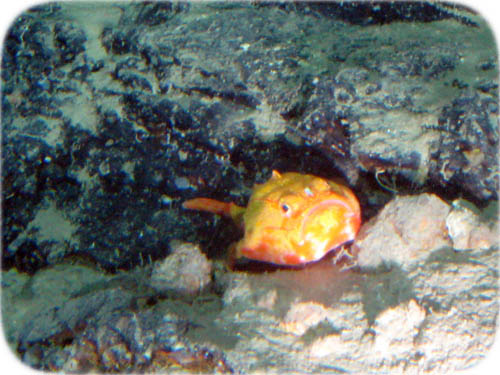
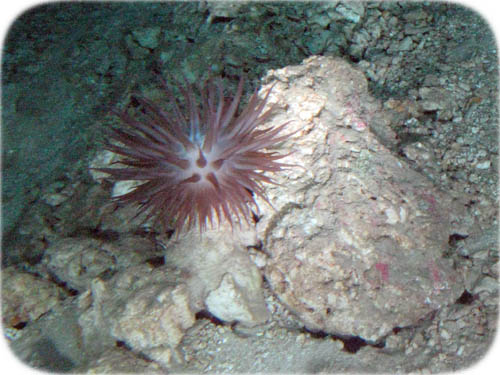
As we ascended, more familiar forms of life emerged: corals and sponges we were familiar with from scuba diving. By 200 feet the scene was much like what we had encountered at 100. Upon surfacing, we navigated back to the pier and the Idabel was hoisted out of the water. We emerged, alive, and went into town with Karl to have a beer. Unfortunately, the woman who makes baliadas had already gone home for the night.
